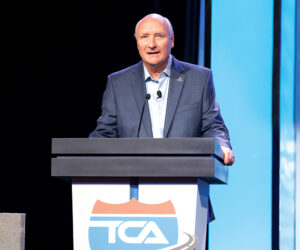Most Americans are familiar with the iconic phrase uttered by actor Tom Hanks in the Academy Award-winning film “Forrest Gump,” spoken as he sits on the bus stop bench and says to the woman sitting next to him, “My momma always said life was like a box of chocolates. You never know what you’re gonna get.”
When President Joe Biden took office and sat down to start opening the symbolic “boxes of chocolates” full of issues he must try to address, there is no question that Biden knew what he would surely find inside the box labeled “Infrastructure”: Crumbling roads, unsafe bridges, and the Highway Trust Fund piggy bank empty.
Of course, this problem is not new.
Since it issued its report card on the nation’s infrastructure in 1988 and followed up with report cards in 1998, 2001, 2005, 2009, 2013, and 2017, the American Society of Civil Engineers has given bridges no higher than C-plus and roads no higher than a D-plus.
As for the funding, everyone except perhaps Rip Van Winkle knows that the federal gas and diesel taxes have not been increased since 1993.
Regardless of why there has been no viable infrastructure plan in years and why the gas and diesel tax hasn’t been increased, the spotlight now beams down on Biden.
Can he do what no other sitting president in recent years has done — actually pass a meaningful infrastructure bill and convince Congress to raise the gas and diesel tax?
Two weeks after he was elected, Biden released what might be called his infrastructure plan. It calls for a $1.3 trillion expenditure over the next 10 years. As for transportation, Biden said the plan would:
- Jump-start the repair of our highways, roads, and bridges;
- Make America roads the world’s safest; and
- Stabilize the Highway Trust Fund (HTF).
The plan notes that it is unacceptable that 1 in 5 miles of the nation’s roads are in poor condition.
“It was critical to get something done four years ago; it’s even more critical now,” said the Truckload Carriers Association’s Vice President of Government Affairs David Heller, who was quick to point out that plans are fine, but useless if the funding is not available.
“We do need to talk about roads and bridges, but we also need to talk about developing a more sustainable form of highway funding that will fund our roads and bridges for years to come,” he said.
The past four years have been all talk, but no action, said Arkansas Trucking Association President Shannon Newton.
“Nothing ever materialized,” she said of former President Donald Trump’s announced intentions. “There was never any consensus. We are hopeful that the bills that were worked on for the last four years might be able to gain some traction and we will see some substantial investment in infrastructure. An infrastructure plan is probably the biggest opportunity that we would foresee or hope for with this administration and this Congress.”
The trucking industry in Alabama and around the country is encouraged by the Biden administration’s support for passage of an infrastructure package that significantly increases funding for surface transportation this year, noted Alabama Trucking Association President Mark Colson. He added that he was both encouraged and discouraged by Department of Transportation Secretary Pete Buttigieg’s testimony at his confirmation hearing.
“We were encouraged by his commitment to addressing the Highway Trust Fund shortfall, and by his statement during his confirmation hearing that all funding options are on the table,” shared Colson. “However, we were disappointed by his statement following the hearing that he’s opposed to increasing the fuel tax, which is the most efficient and equitable way to fund highways.”
With the Democrats in control of Congress, it may be easy to push an infrastructure plan through the House and Senate, but Buttigieg’s opposition to an increase in the HTF, and a recent comment about the possibility of a vehicle miles traveled tax may mean truck drivers will encounter bad roads and congestion because of the lack of improved highways for some time to come.
While they may not agree on the exact amount, both the federal government and transportation stakeholders agree the HTF could go in the hole sometime this fiscal year and, unless new sources of funding are found, the fund will be in the red by $125-$150 billion in 2030.
The Congressional Budget Office (CBO) calls an increase in the gas and diesel tax the “most forward option” for propping up the HTF.
As an example, the CBO estimates that increasing the gas and diesel tax by 15 cents per gallon in 2021 and indexing to inflation thereafter would raise an additional $329 billion of revenue over the 2021-2030 budget window, enough to eliminate the HTF’s shortfall and provide $140 billion of additional spending or deficit reduction through 2030.
The trucking industry has put a responsible solution on the table, said Alabama’s Colson.
“The Build America Fund proposal would increase federal fuel tax by 20 cents (5 cents per year over four years) plus indexing to keep up with inflation and improvements in fuel efficiency. It would raise around $340 billion over 10 years and would cost the average four-wheeler around $2 per week,” he said. “We are the largest payer of motor fuels taxes by a long shot.”
Colson said in Alabama for example, truck drivers pay nearly 40% of the fuel taxes yet only represent 10% of the vehicle miles traveled.
“That said, we are willing to once again put our money where our mouth is and support paying our share to improve American’s roadways,” he said. “It is the right thing to do. Improving our roads saves lives and creates jobs. It’s a no-brainer.”
While the administrative costs of taxes other than fuel tax, such as a vehicle miles traveled or a freight traveling by highway, are substantial, that isn’t the case for the fuel tax.
“The administrative cost for the fuel tax is 1%, which means for every dollar that’s paid fuel tax, 99 cents go directly to the HTF,” said Heller.
So, what is going to happen absent a true infrastructure plan and money to fund it?
Heller likens the situation to a visit to the doctor’s office.
“They point to that pain-level chart and ask you on a scale of one to 10, what’s your pain level?” he said. “Instead of a pain-level chart, look at the ASCE’s rating for highways has been D-plus or lower since 1998 and bridges C-plus or less during the same time period.”
Translated into a pain rating, that could easily mean an eight, nine or perhaps even a 10.
Ouch!
Lyndon Finney’s publishing career spans over 55 years beginning with a reporter position with the Southwest Times Record in Fort Smith, Arkansas, in 1965. Since then he’s been a newspaper editor at the Southwest Times Record, served five years as assistant managing editor of the Arkansas Democrat-Gazette in Little Rock and from November 2004 through December 2019 served as editor of The Trucker. Between newspaper jobs he spent 14 years as director of communications at Baptist Health, Arkansas’ largest healthcare system. In addition to his publishing career he served for 46 years as organist at Little Rock’s largest Baptist church.








